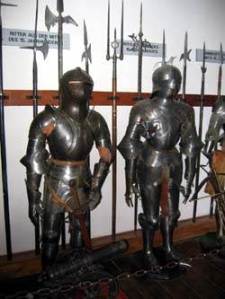|
 Before leaving the castle, we walked around
Burg Gutenfels and took some more pictures.
Our next stop was Marksburg, which is the only hill castle on the Rhein that has never been destroyed. Their tour
brochure claims that "Unlike all other Rhein castles which were rebuilt from ruins (most of them all too fancifully)
the Marksburg is quite 'genuine'".
Before leaving the castle, we walked around
Burg Gutenfels and took some more pictures.
Our next stop was Marksburg, which is the only hill castle on the Rhein that has never been destroyed. Their tour
brochure claims that "Unlike all other Rhein castles which were rebuilt from ruins (most of them all too fancifully)
the Marksburg is quite 'genuine'".
A group of students and a German family were in the same group as us on the tour Marksburg. The teacher got into a heated
discussion with our tour guide, which we did not understand. Later the family told us the teacher did not want the family or us
to be in the same group as them. We think she didn't want her students to disturb us.
 The Lords of Eppstein built Marksburg in the 11th or 12th century. A few of the highlights in Marksburg include an armory that
houses a collection of personal armor illustrating the historical development of armour from 600 B.C. - 1500 A.D.,
a wine-press from 1767, a painted chapel ceiling, and an indoor toilet (quite rare at that time).
The Lords of Eppstein built Marksburg in the 11th or 12th century. A few of the highlights in Marksburg include an armory that
houses a collection of personal armor illustrating the historical development of armour from 600 B.C. - 1500 A.D.,
a wine-press from 1767, a painted chapel ceiling, and an indoor toilet (quite rare at that time).
There was a small cafe at Marksburg, and we were getting hungry, so we bought
Goulaschsuppe and
Currywurst (both with
brot) and a Fanta for lunch before beginning
the walk back down to our car. There was a shop built into the walkway that led up to the castle, which we had passed in a hurry on the way up.
On the way down to the car we stopped and spent some time browsing at the shop. It sold a wide variety of very old documents, mostly single
pages from the 16th to 19th century. We purchased a sheet of music from circa 1700 as a christmas present for Paul's dad. The sheet music was hand drawn, but shortly after the time it was created sheet music began to be
printed on a press.
After leaving Burg Gutenfels we headed north along the east bank of the Rhein River. We were heading to Koblenz to
cross over the bridge there. There are suprisingly few bridges over the Rhein river, but that does not hinder the people who
live in this area, because they use convenient
auto-ferries to cross when they are not near a bridge. We were intimidated by that and decided that since Schloss Stolzenfels
was so close to Koblenz, we might as well use the bridge.
 Schloss Stolzenfels is not an authentic Medieval castle. It was reconstructed in the neo-Gothic style in 1842 by Friedrich-Wilhelm IV.
We arrived right as a tour was starting, so we quickly paid. We received a laminated paper with the English translation of the tour. Although
the tour guide was very verbose, it seemed like we only had about 20% of what he was saying on the sheet. The interior of the castle was arranged
as a museum, and at one point we had to don slippers over our shoes to protect the antique wooden floors.
Schloss Stolzenfels is not an authentic Medieval castle. It was reconstructed in the neo-Gothic style in 1842 by Friedrich-Wilhelm IV.
We arrived right as a tour was starting, so we quickly paid. We received a laminated paper with the English translation of the tour. Although
the tour guide was very verbose, it seemed like we only had about 20% of what he was saying on the sheet. The interior of the castle was arranged
as a museum, and at one point we had to don slippers over our shoes to protect the antique wooden floors.
We wanted to continue south along the west bank of the Rhein River, but the speed limit along the river was very low, and we didn't want to get home2 too late.
We needed to do laundry, so we decided to just head back to Gemund. On the way home2 we stopped and picked up an order for take-out (although in Europe everyone seemed to call it "take-away")
which consisted of Pekingsuppe, sauer-scharf, Spargelsuppe mit Hühnerfleisch, Hühnerfleisch mit Curry, und Gemüse, Scharf, and Hühnerfleisch nach Kung-Bao
Art mit Chin. Gemüse und Cashewnüssen, Scharf from Kim-Sön, a local Chinese restaurant. While we were waiting for
the food, the manager brought out some complimentary shots of some kind of creamy fruit drink that we thought might have been some kind of appetizer
or dessert. Our fortune cookie contained
the message "Good luck is the result of good planning", so after dinner we read more of our Paris guide books while we did the laundry.
After putting the laundry in the dryer, we took a break in the sauna before heading to bed.
|

